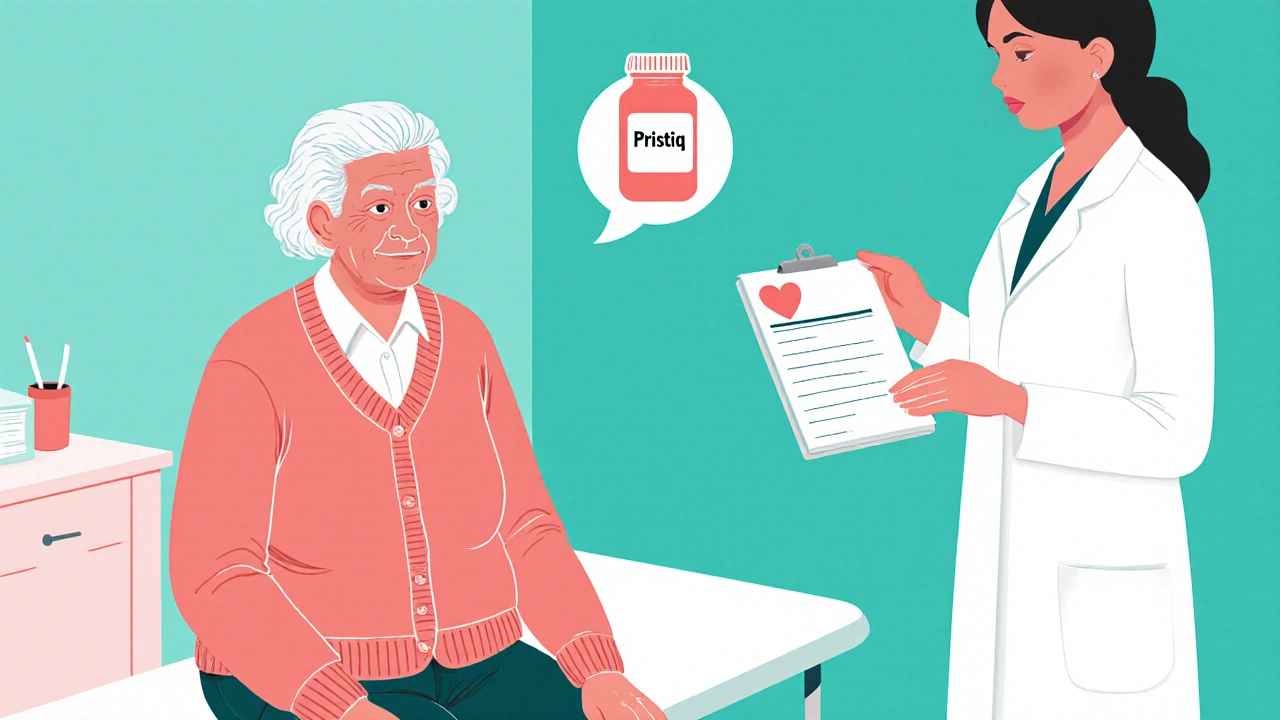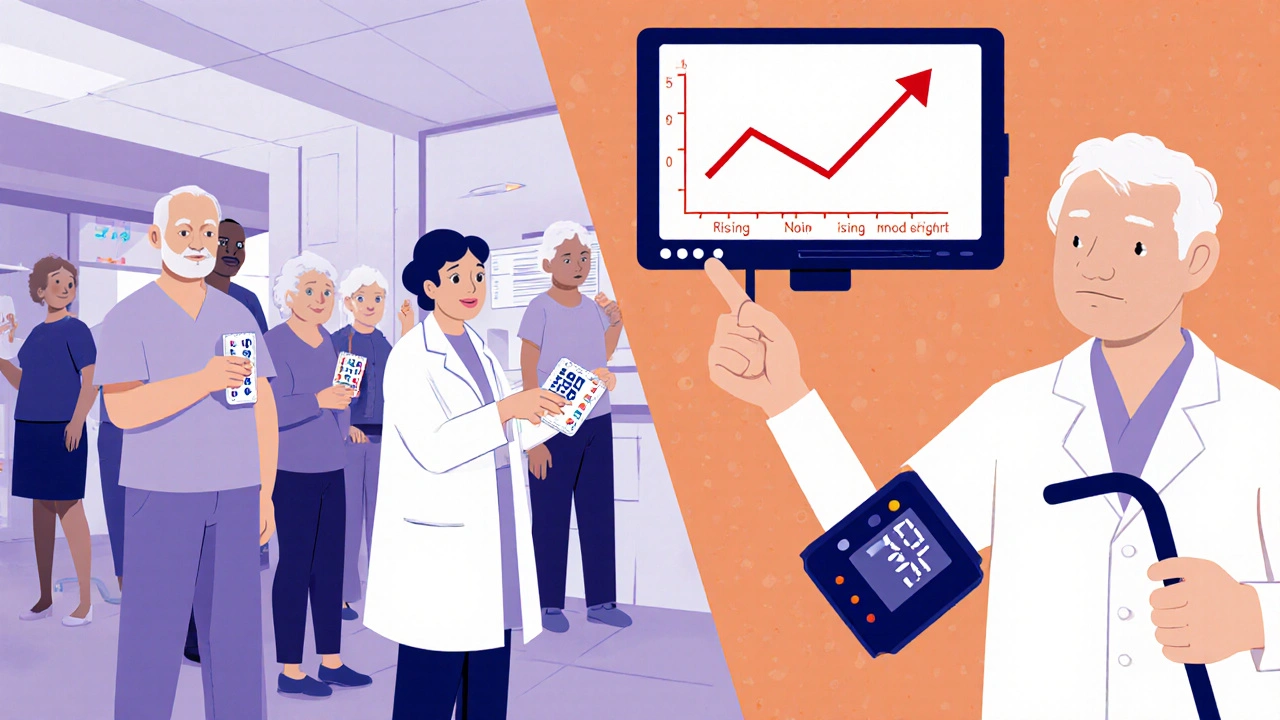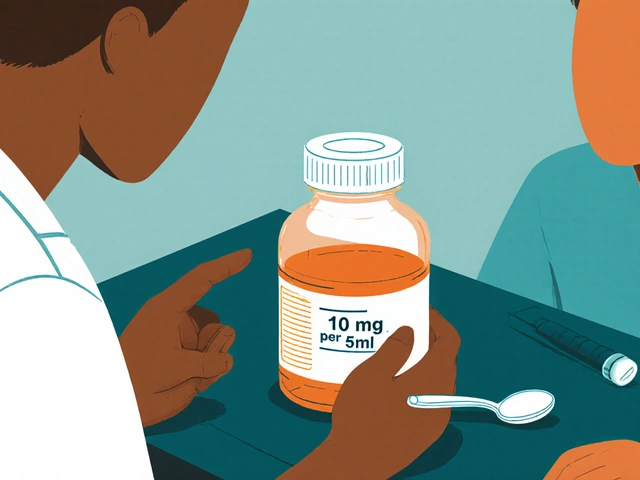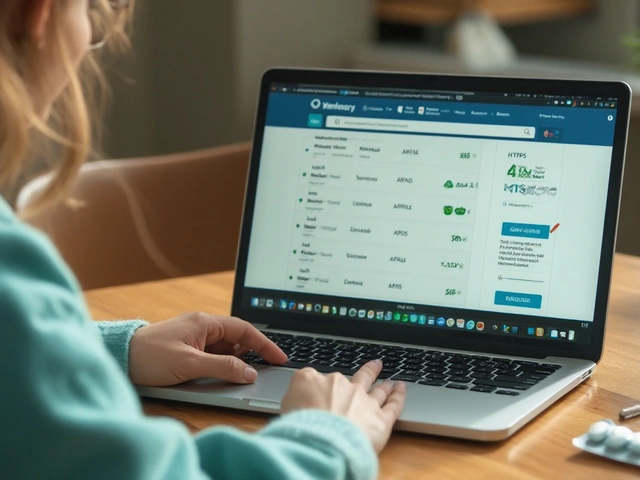
When it comes to treating depression in older adults, clinicians often walk a tightrope between effectiveness and tolerability. Desvenlafaxine is a serotonin‑norepinephrine reuptake inhibitor (SNRI) approved for major depressive disorder (MDD). While it’s widely used in the general adult population, its profile in people aged 65 and over raises distinct questions. This guide walks you through the pharmacology, clinical evidence, dosing tricks, and safety alerts you need to feel confident prescribing-or taking-desvenlafaxine in later life.
What Makes Desvenlafaxine Different?
Desvenlafaxine (brand name Pristiq) is the major active metabolite of venlafaxine. It was approved by the FDA in 2008 for adults with MDD. Unlike its predecessor, desvenlafaxine does not rely heavily on CYP2D6 metabolism, which reduces variability among patients who are poor metabolizers.
Key pharmacologic attributes:
- Peak plasma levels in about 7.5 hours.
- Half‑life of roughly 11 hours, supporting once‑daily dosing.
- Balanced inhibition of serotonin (5‑HT) and norepinephrine (NE) reuptake, with a ratio close to 1:1 at therapeutic concentrations.
These features translate into a predictable exposure curve-a plus when you’re dealing with polypharmacy in older adults.
Clinical Efficacy in the Elderly
Evidence for desvenlafaxine’s efficacy in people 65+ comes from a handful of randomized controlled trials (RCTs) and post‑marketing observational studies. A 2022 multicenter RCT enrolled 410 patients aged 65‑85 with moderate‑to‑severe MDD. After eight weeks, the desvenlafaxine arm (50 mg/day) showed a mean reduction of 10.2 points on the Hamilton Depression Rating Scale (HDRS‑17), compared with 6.8 points for placebo (p < 0.001). The effect size (Cohen’s d = 0.68) is comparable to younger cohorts.
Real‑world data echoed these results. A 2023 registry analysis of 2,117 Medicare beneficiaries found that patients who stayed on desvenlafaxine for at least 12 weeks had a 22 % lower risk of hospitalization for depressive relapse than those on selective serotonin reuptake inhibitors (SSRIs).
Safety Profile: What to Watch For
Older adults are more vulnerable to side effects that can tip the balance toward harm. Here are the most clinically relevant adverse events:
- Hypertension: SNRI‑related increases in blood pressure occur in ≈8 % of elderly patients. Routine monitoring is essential, especially if baseline systolic ≥ 140 mm Hg.
- Falls and Syncope: Orthostatic dizziness has been reported in 5‑7 % of patients over 70. Start low, go slow.
- Sexual Dysfunction: While less prevalent than with SSRIs, it still affects around 12 % of older users.
- Serotonin Syndrome: Rare (<0.1 %) but potentially fatal if combined with other serotonergic agents (e.g., tramadol, linezolid).
- Renal Impairment: Desvenlafaxine is ~45 % renally excreted; dose reduction is recommended when eGFR < 30 mL/min/1.73 m².
Overall, the incidence of serious adverse events in the over‑65 group does not exceed that of other SNRIs, but the margin of safety narrows because of comorbidities and drug interactions.

Dosage Adjustments for Older Adults
The standard adult dose is 50 mg once daily, with a maximum of 200 mg. For elderly patients, the following titration scheme works well:
- Start at 25 mg daily (half a tablet) for the first week.
- If tolerated, increase to 50 mg on day 8.
- Assess response after 4-6 weeks; consider a modest increase to 75 mg only if depressive symptoms remain moderate and blood pressure is stable.
Never exceed 100 mg without specialist input, as the risk of hypertension and tachycardia rises sharply above that threshold in the elderly.
Drug Interactions to Consider
Polypharmacy is the rule, not the exception, in geriatric care. Key interaction culprits include:
- Warfarin: Desvenlafaxine can increase INR; monitor INR weekly for the first month.
- NSAIDs: Heightened bleeding risk, especially with concurrent anticoagulants.
- Tramadol and other serotonergic analgesics: Additive serotonin syndrome risk.
- Beta‑blockers: May blunt the hypertensive response but also mask tachycardia signs.
Always run a comprehensive medication review before starting or adjusting desvenlafaxine.
Monitoring and Assessment Tools
Regular assessment helps catch problems early. Recommended schedule:
- Baseline: Blood pressure, heart rate, ECG (if history of cardiac disease), eGFR, and complete blood count.
- Week 1-2: Check blood pressure and adverse symptom checklist.
- Week 4: Re‑evaluate depression severity using the Geriatric Depression Scale (GDS‑15). A drop of ≥ 4 points signals a good response.
- Every 3 months: Review renal function and medication list.
Document any new falls, dizziness, or changes in cognition, as these may herald dose‑related issues.
How Does Desvenlafaxine Stack Up Against Other SNRIs?
Clinicians often wonder whether to reach for desvenlafaxine or stick with venlafaxine or duloxetine. The table below summarizes the most relevant attributes for the elderly.
| Attribute | Desvenlafaxine | Venlafaxine | Duloxetine |
|---|---|---|---|
| Typical start dose (elderly) | 25 mg QD | 37.5 mg QD | 30 mg QD |
| Maximum recommended dose | 100 mg QD (caution > 75 mg) | 150 mg QD | 60 mg QD |
| Half‑life | ≈ 11 h | ≈ 5 h (active metabolite 11 h) | ≈ 12 h |
| Metabolism pathway | Minimal CYP2D6 involvement | Extensive CYP2D6 | CYP1A2 & CYP2D6 |
| Common elderly side effects | Hypertension, dizziness | Hypertension, nausea | Dry mouth, liver enzymes↑ |
| Renal dosing adjustment | Yes, if eGFR < 30 | No specific adjustment | Yes, if eGFR < 30 |
| Drug‑interaction risk (CYP) | Low | High | Moderate |
Overall, desvenlafaxine offers a cleaner metabolic profile, making it a safer first‑line SNRI for older patients with complex medication regimens.
Practical Recommendations for Clinicians
- Start low (25 mg) and titrate slowly; avoid jumping to 100 mg unless absolutely necessary.
- Screen for hypertension at baseline and after each dose increase.
- Use the GDS‑15 or HDRS‑17 to track response; aim for at least a 4‑point drop by week 4.
- Check renal function before initiating therapy and again if eGFR < 45 mL/min/1.73 m².
- Educate patients and caregivers about signs of serotonin syndrome and bleeding.
By following these steps, you can maximize the antidepressant benefits while keeping side‑effects in check.
Frequently Asked Questions
Is desvenlafaxine safe for patients over 80?
Yes, but start at 25 mg daily, monitor blood pressure closely, and adjust for renal function. Real‑world data shows comparable efficacy to younger adults when doses stay ≤ 75 mg.
Can I switch a patient from venlafaxine to desvenlafaxine?
A direct switch is possible because desvenlafaxine is the active metabolite of venlafaxine. Cross‑taper over 1‑2 weeks (e.g., reduce venlafaxine by 37.5 mg while starting desvenlafaxine at 25 mg) helps avoid withdrawal.
What should I do if the patient develops hypertension?
First, verify the reading and rule out white‑coat effect. If systolic stays ≥ 150 mm Hg, consider reducing the dose to 25 mg or switching to an SSRI with a lower hypertensive risk. Add or adjust antihypertensive therapy as needed.
Is dose adjustment needed for patients with mild liver disease?
Mild hepatic impairment (Child‑Pugh A) generally does not require dose changes because the drug is cleared mainly by the kidneys. Monitor liver enzymes if the patient is on other hepatotoxic meds.
How long should treatment continue in the elderly?
Guidelines suggest at least 6‑12 months of continuous therapy after remission, provided side‑effects are tolerable. Longer courses are reasonable for recurrent depression.
Understanding the nuances of desvenlafaxine in older adults equips you to make informed, patient‑centered decisions. With careful dosing, vigilant monitoring, and awareness of drug interactions, you can tap into the drug’s antidepressant power while keeping the safety net tight.
Donal Hinely
Alright, let’s cut to the chase-desvenlafaxine can be a real beast if you don’t keep an eagle eye on blood pressure. Start patients on 25 mg, check their systolic numbers after the first week, and don’t be shy about dialing it back if they’re flirting with 150 mm Hg. Keep a log of any dizzy spells; the elderly can flip faster than a pancake in a skillet. And for the love of all that’s holy, watch those drug‑drug interactions like you’re guarding the crown jewels.
eko lennon
When I first laid eyes on this guide I felt like I’d stumbled into a treasure chest of geriatric psychiatry gold, and let me tell you, the depth of detail is nothing short of majestic. The author painstakingly dissects the pharmacokinetics, reminding us that a half‑life of roughly eleven hours translates into a once‑daily rhythm that meshes beautifully with the chaotic lives of seniors. One cannot overlook the elegant discussion of CYP2D6 independence, which, in a world awash with metabolizer variability, is a breath of fresh air for clinicians juggling polypharmacy. The clinical efficacy section reads like a page‑turner, with the 2022 RCT data painted vivid as a sunrise over the Rockies, showcasing a ten‑point drop on the HDRS‑17 that would make any psychiatrist weak at the knees. Equally riveting is the real‑world evidence drawn from a 2023 Medicare registry, where a 22 % reduction in hospitalization stands as a testament to the drug’s pragmatic potency. Safety considerations are handled with the precision of a surgeon’s scalpel, flagging hypertension, orthostatic dizziness, and the ever‑looming specter of serotonin syndrome in a manner that feels both thorough and humane. I especially appreciate the “start low, go slow” mantra, which echoes the age‑old adage that patience is a virtue, especially when navigating the frail physiologies of octogenarians. The dosing table, though modest in size, packs more punch than a heavyweight bout, delineating clear thresholds for renal adjustment and the sweet spot of 25 mg increments. Moreover, the guide’s practical recommendations read like a seasoned coach’s playbook, urging clinicians to employ the GDS‑15 or HDRS‑17 as their north star for tracking therapeutic response. The FAQ section, with its crisp answers about switching from venlafaxine and handling hypertension, feels like a seasoned mentor whispering sage advice in a crowded hallway. What truly sets this guide apart, however, is its unwavering commitment to patient‑centered care, weaving together pharmacology, evidence‑based practice, and bedside empathy into a tapestry that could easily become a staple on every geriatric psychiatrist’s bookshelf. In my own practice, I have already begun to implement the suggested monitoring schedule, and the early results are as encouraging as a spring thaw after a long winter. The narrative flow, the balanced tone, and the judicious use of jargon make this not just a reference but a conversational companion for anyone daring to prescribe in the twilight years. So, kudos to the author for delivering a guide that feels both scholarly and approachable, and may we all heed its wisdom as we strive to keep our older patients both stable and hopeful.
Sunita Basnet
Utilizing desvenlafaxine in geriatric cohorts necessitates pharmacovigilance optimization via systolic monitoring protocols and renal clearance assessments. Adherence to evidence‑based titration schemas mitigates adverse event incidence.
Melody Barton
I’ve seen a lot of seniors struggle with depression and this guide nails the sweet spot between safety and effectiveness. Starting at 25 mg and moving up only when blood pressure stays calm is a solid game plan. Keep an eye on those orthostatic drops – a quick sit‑to‑stand test can save a fall. Overall, it feels like a real lifeline for both patients and the clinicians caring for them.
Justin Scherer
You hit the nail on the head – the sit‑to‑stand test is underrated and can catch dizziness before it turns into a tumble. I also add a simple BP log each morning; it gives a clear trend without overwhelming the patient. Thanks for sharing the practical pointers.
Pamela Clark
Wow, another “groundbreaking” guide about an SNRI that’s been around since 2008 – how original.
Diane Holding
Originality isn’t the point; clarity is.
Cheyanne Moxley
Honestly, if you’re not already using this as your bedside bible, you’re doing it wrong. The guide lays out the whole roadmap and anyone slacking on monitoring is basically gambling with their patients.






Write a comment